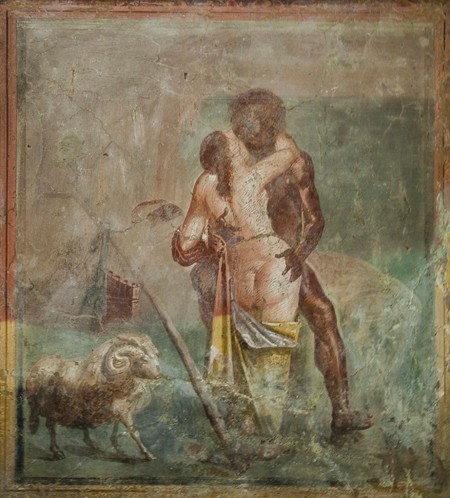While Latin love poets, such as Catullus, Propertius, Tibullus, and Ovid, revolutionized ancient amatory poetry by articulating a new fantasy of everlasting heterosexual love, Roman wall painting underwent an equally radical change. Instead of the skillful imitation of colored marbles popular in the third and second centuries BCE and the trompe-l’oeil fantasies of the first half of the first century BCE, Roman frescoes now frequently featured illusionistically framed narrative panels of amorous subjects, mostly drawn from myth. As in elegy, the painted lovers on the walls of Roman houses appear in scenes that, while powerfully evocative, stop short of depicting the sexual act. Such images focus instead on metonymic signs of desire and affection: the touching of hands, the couple’s interlocked gaze, lips that part and are (almost) joined. Confronting these two bodies of evidence on equal terms, my book poses two closely related questions: why did Roman poets, painters, and their audiences at the dawn of the empire become so interested in matters of love? And why, once this new poetic and pictorial discourse on tenderness took shape, did it become so pervasive throughout Roman art, literature, and culture?
I argue that the answer lies in the profound social and cultural changes that came about with the end of the Roman civil wars and the rise of Augustus. In this period, core concepts such as citizenship, family, and marriage were being redefined. Augustus’s marriage laws (promulgated in 18 and 17 BCE) not only made marriage obligatory for the great majority of adult citizens but also dictated who was allowed to marry whom. Latin love elegy, which adapts the Augustan discourse on marriage and the family to laud the elegiac poets’ lifelong attachment to their mistresses, has often been seen as a witty critical response to these events. But as I demonstrate, that response had broader cultural significance than has been realized. Although an interest in sentimental portrayals of amorous subjects first manifested itself among members of Rome’s aristocracy, it did not remain an elite phenomenon for long. One of the developments my book traces is the co-optation of the elegists’ ideal of a life of love by mainstream Roman familial ideology and its subsequent diffusion among upwardly mobile, socially ambitious citizens living on the Bay of Naples. By focusing on the literary and artistic innovations that marked the first one hundred years of the empire (c. 30s BCE–70s CE), I offer a nuanced account of the emergence of a Roman ideal of amatory tenderness and its transformation into a widespread cliché—a cliché that would inform later notions of romantic love in the West, but whose early history has long been overlooked.
During my time at CASVA, I focused primarily on expanding and revising the chapter dedicated to one of the most frequently depicted mythological lovers in Roman wall painting: the Cyclops, Polyphemus. In Roman poetic and pictorial representations of the romance between Polyphemus and Galatea, the Cyclops is portrayed as a long-suffering, sympathetic character whose troubles parallel those experienced by the human lovers of Latin elegy, who constantly lament the fickleness and cruelty of their mistresses. Generally perceived as an ill-fated love affair, the story of Polyphemus’s infatuation with a beautiful and elusive sea nymph inspired numerous pictorial compositions that emphasized the insurmountable distance between them. Yet in one example dated to the late first century CE, a fresco from the House of the Ancient Hunt in Pompeii, Polyphemus and Galatea are joined in a Hollywood-style kiss. By alluding to a possible happy end, this image emblematizes the impact of a Roman aesthetic of tenderness, which transformed this terrifying creature into a romantic hero whose apparent monstrosity became a mark of his essential humanity.
